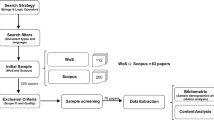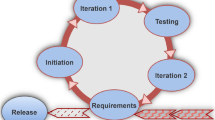Abstract
The crowdsourcing, as a service pattern in cloud environment, usually aims at the cross-disciplinary cooperation and creating value together with customers and becomes increasingly prevalent. Software process, as a kind of software development and management strategy, is defined as a series of activities implemented by software life cycle and provides a set of rules for various phases of the software engineering to achieve the desired objectives. With the current software development cycle getting shorter, facing more frequent needs change and fierce competition, a new resource management pattern is proposed to respond to these issues agilely by introducing the crowdsourcing service to agile software development for pushing the agility of software process. Then, a user-oriented resource scheduling method is proposed for rational use of various resources in the process and maximizing the benefits of all parties. From the experimental results, the proposed pattern and resources scheduling method reduces greatly the resource of project resource manager and increases the team resource utilization rate, which greatly improves the agility of software process and delivers software products quickly in crowdsourcing pattern.
Similar content being viewed by others
References
NASIM R, MUSTAFA T. Agile software development and its successful factor: A literature review [J]. International Journal of Management, IT and Engineering, 2015, 5(4): 286–292.
van KELLE E, van DER WIJST P, PLAAT A. An empirical study into social success factors for agile software development [C]// Cooperative and Human Aspects of Software Engineering (CHASE), 2015 IEEE/ACM 8th International Workshop on. IEEE, 2015: 77–80.
PERKUSICH M, SOARES G, ALMEIDA H. A procedure to detect problems of processes in software development projects using Bayesian networks [J]. Expert Systems with Applications, 2015, 42(1): 437–450.
KAUR R, SENGUPTA J. Software process models and analysis on failure of software development projects [J]. International Journal of Scientific & Engineering Research, 2011, 2(2): 1–4.
SILVA F S, SOARES F S F, PERES A L. Using CMMI together with agile software development: A systematic review [J]. Information and Software Technology, 2015, 58: 20–43.
BRHEL M, METH H, MAEDCHER A. Exploring principles of user-centered agile software development: A literature review [J]. Information and Software Technology, 2015, 61(C): 163–181.
ANSLOW C, MAURER F. An experience report at teaching a group based agile software development project course [C]// Proceedings of the 46th ACM Technical Symposium on Computer Science Education. ACM, 2015: 500–505.
WANG H, YIN G, LI X. TRUSTIE: A software development platform for crowdsourcing [M]// Crowdsourcing. Berlin, Heidelberg: Springer, 2015: 165–190.
KURIAKOSE J, PARSONS J. An enhanced requirements gathering interface for open source software development environments [C]// 2015 IEEE 23rd International Requirements Engineering Conference (RE). IEEE, 2015: 288–289.
DWARAKANATH A, CHINTALA U, VIRDI G. Crowd build: A methodology for enterprise software development using crowdsourcing [C]// Proceedings of the Second International Workshop on Crowdsourcing in Software Engineering. IEEE, 2015: 8–14.
CHAISIRI S, LEE B S, NIYATO D. Profit maximization model for cloud provider based on windows azure platform [C]// 2012 9th International Conference on Electrical Engineering/ Electronics, Computer, Telecommunications and Information Technology (ECTI-CON). Phetchaburi, 2012: 1–4.
CAO Jun-wei, HWANG Kai, LI Ke-qin. Optimal multiserver configuration for profit maximization in cloud computing [J]. IEEE Transactions on Parallel and Distributed Systems, 2012, 24(6): 1087–1096.
GHOSH R, LONGO F, NAIK V K. Modeling and performance analysis of large scale iaas clouds [J]. Future Generation Computer Systems, 2013, 5(29): 1216–1234.
MANVI S S, SHYAM G K. Resource management for infrastructure as a service (Iaas) in cloud computing: A sarvey [J]. Journal of Network and Computor Application, 2014, 41: 424–440.
GHOSH R, LONGO F, NAIK V K. Modeling and performance analysis of large scale iaas clouds [J]. Future Generation Computer Systems, 2013, 5(29): 1216–1234.
ABIRAMI S P, RAMANATHAN S. Linear scheduling strategy for resource allocation in cloud environment [J]. International Journal on Cloud Computing: Services and Architecture (IJCCSA), 2012, 2(1): 9–17.
KIM H, KIM W, KIM Y. Experimental study to improve resource utilization and performance of cloud systems based on grid middleware [J]. Journal of Communication and Computer, 2010, 7(12): 32–43.
SOTOMAYOR B, KEAHEY K, FOSTER I. Combining batch execution and leasing using virtual machines [C]// Proceedings of the 17th International Symposium on High Performance Distributed Computing. ACM, 2008: 87–96.
GARG S K, YEO C S, ANANDASIVAM A, BUYYA R. Energy-efficient scheduling of HPC applications in cloud computing environments [J]. Computer Science, 2009, arXiv:0909.1146.
BRADLEY D J, HARPER R E, HUNTER S W. Workload-based power management for parallel computer systems [J]. IBM Journal of Research and Development, 2003, 47(5.6): 703–718.
CHEN Y, DAS A, QIN W. Managing server energy and operational costs in hosting centers [C]// ACM SIGMETRICS Performance Evaluation Review. ACM, 2005, 33(1): 303–314.
WU L, GARG S K, BUYYA R. SLA-based resource allocation for software as a service provider (SaaS) in cloud computing environments [C]// Cluster, Cloud and Grid Computing (CCGrid), 2011 11th IEEE/ACM International Symposium on. IEEE, 2011: 195–204.
Author information
Authors and Affiliations
Corresponding author
Additional information
Foundation item: Projects(61304184, 61672221) supported by the National Natural Science Foundation of China; Project(2016JJ6010) supported by the Hunan Provincial Natural Science Foundation of China
Rights and permissions
About this article
Cite this article
Long, F., Yang, C., Rong, Hg. et al. A user-oriented resource scheduling method for improving agile software pattern in cloud environment. J. Cent. South Univ. 23, 2906–2916 (2016). https://doi.org/10.1007/s11771-016-3354-z
Received:
Accepted:
Published:
Issue Date:
DOI: https://doi.org/10.1007/s11771-016-3354-z




